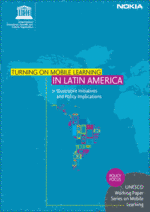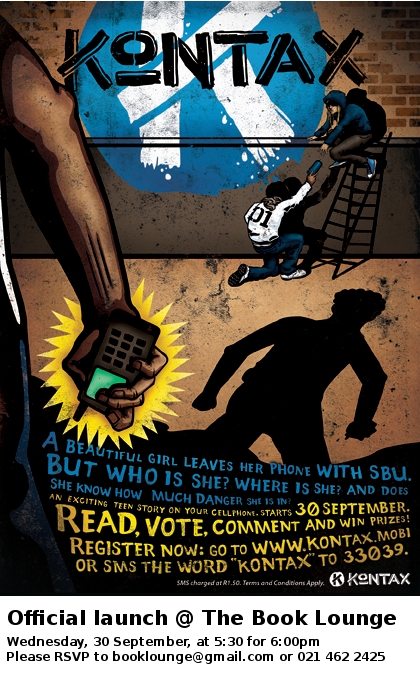This is my “brag pack” for 2010. Read the one for 2009.
What I did
As fellow for 21st century learning at the Shuttleworth Foundation I spent the year focusing on my m4Lit, or mobiles for literacy, project. It was launched in 2009 as a pilot initiative to explore whether teens in South Africa will read stories on their mobile phones. It turns out that they will, and based on the success of the pilot phase, I was given another Fellowship year.
Phase 2 of the project essentially involved i) offering more content (which our readers had asked for), ii) improving the user experience, iii) growing the user base, and iv) working towards sustainability.
The Praekelt Foundation was brought in to redevelop the content management system. The new system publishes to a mobisite, www.yoza.mobi, as well as onto MXit (before these were two separate systems), with additional features for interactivity such as easy commenting, voting and reviewing. I called the new offering Yoza Cellphone Stories, and assembled a freelance team to help me run it: top South African authors, an editor, graphic designer, moderators, and social media mavens.
Yoza was launched in August with fourteen stories. Today there are twenty-one stories — in English, Afrikaans and isiXhoza — and growing. Publication of new stories happens on the first of every month, with writing competitions happening all the time.
What worked
1. Publishing a broader range of content, such as soccer (Streetskillz), chick-lit (Sisterz) and teen issues (Confessions), in addition to the Kontax teen adventure series, was very well received. We also published five Shakespeare plays that are being studied by South African learners.
From 2009, our m-novels have collectively been read more than 60,000 times, our readers have posted more than 40,000 comments and submitted more than 10,000 competition entries!

Feedback from our readers is mostly positive: it is clear that we are educating as well as entertaining our readers.
“I must say: the story line it self is gripping, for somereasen everytime i read the kontax stories am kept at the erge of my sit. They are always grattifiying and i can hardly wait for another1. Thank you to the contax team cause for the 1st time in years i am reading again and i lov reading now, and am a guy so you i just dont lyk readin. So thank u again guyz you da best,” by Mphuthumi Busakwe, commenting on Kontax 5: The Sext Files.
“Gr8 story guyz.. I can’t wait 4 th nxt one 2 b published. I’m totally addicted! Love th fact tht Jayden nd Latoya r bck 2gethr. P.s Please give us more than one chapter a day,” by Ms. Makes, commenting on Sisterz 2: Hidden Danger.
“2 all soccer lovers,esp players,here r technical tips,grab them. Gud luck 2d team!” by Assah, commenting on Streetskillz 2: Silver’s Treasure.
It is also clear that there is an implicit conversation happening between the story — and sometimes the Yoza brand — and the readers. We create interesting and deliberately provocative scenarios in the stories to elicit reader opinion, and they usually respond in full force. An example is the comments on this Sisterz chapter (first read the WHAT DO YOU THINK comment prompt on that page).
2. The new interface is more user-friendly and easier to maintain. The actual CMS will be open-sourced.
3. Being on MXit in Kenya has given the project a greater profile.
4. Our stories have also been published on Young Africa Live on the Vodafone Live portal, as well as on MYMsta.mobi, loveLife’s mobile social network. Two high school teachers in the Western Cape have been in contact to say that they are using Yoza in the English classroom.
5. The READ Educational Trust runs an annual Readathon competition, and for the first time teens could enter the writing competition on Yoza via their mobile phones. We also ran writing competitions in conjunction with the Sunday Times and The Sowetan newspapers.
6. We have an open call for writers to contribute stories to Yoza. So far three have been published by authors from Lapa Publishers.
 7. The m4Lit project received an Honourable Mention in the Stockholm Challenge award, and has received much media coverage, both locally and internationally, including from School Library Journal, Global Post, City Press, Argus, EP Herald, The Times, M&G Online, Rapport, West Cape News, ITWeb, Soulbeat, Drum Beat, Mashable, Puku, Idasa, GSMA Development Fund, Educational Technology Debate, 5fm, YFM, East Coast Radio and the Voice of the Cape.
7. The m4Lit project received an Honourable Mention in the Stockholm Challenge award, and has received much media coverage, both locally and internationally, including from School Library Journal, Global Post, City Press, Argus, EP Herald, The Times, M&G Online, Rapport, West Cape News, ITWeb, Soulbeat, Drum Beat, Mashable, Puku, Idasa, GSMA Development Fund, Educational Technology Debate, 5fm, YFM, East Coast Radio and the Voice of the Cape.
Bottom line: Throughout the year I have said, and still say, that the cellphone is a powerful learning and communication tool. Instead of viewing it as a distraction and a hindrance to education, I believe it should be viewed as an essential part of the solution. It is the e-reader of Africa, a device onto which we can quickly and easily publish content to a wide audience, as well as through which young people are given a voice. The high-levels of engagement on Yoza has shown that participatory culture is alive and well in Africa, although here it is via MXit comments and not Youtube videos.
What still needs work
1) Yoza is not producing enough content to feed the mobile monster. Our readers want more and they want it now. They don’t like waiting for the first of the next month to get their next story fix.
2) There is a novelty factor to m-novels. The Yoza stories have not had as many reads and competition entries as the first Kontax stories. Although more comments are made on Yoza stories than before. This novelty-factor has forced us to continually try to improve the user experience and offer targeted content.
3) Sustainability is still not resolved. At this stage, m4Lit has not secured any revenue other than the Shuttleworth Foundation funding, although a number of positive conversations are currently underway for sponsorship.
Future plans
A clear business opportunity has emerged. Our readers are crying out for content about issues, e.g. teen pregnancy or how to handle money. Below is a word cloud of what our readers told us they want to read about. As you can see, it covers the full range of “issues”.

Non-profit organisations, governments and corporates want to communicate their messages to young people, e.g. healthy sexual behaviour or financial literacy. Yoza is the bridge between these groups.
We now have a platform to run Yoza, a team that can offer full-service mobile content campaigns, and a MXit footprint in South Africa and Kenya, with plans to grow into other countries. We are well-placed to transition from Yoza the “cellphone stories library” to Yoza the “mobile social marketing service”. A major milestone is to secure a big first sponsor.
We want young people across Africa to use their phones for reading, writing and learning – and believe that this can ultimately be a positive influence on their lives. In short: more content, more users, more participation, and greater impact.
Living out loud
As Fellows we are required to “live out loud”. On the topic of mlearning, I am a regular event speaker and panelist. I have presented on m4Lit at TEDx Soweto (watch video) and Tech4Africa, eLearning Africa in Zambia, and twice at the World Bank in Washington. I recently gave a thematic keynote at the Open Innovation Africa Summit in Kenya, and at the International Seminar on Mobile Technologies for Learning and Development in Barcelona.
I have been Interviewed by BBC’s Digital Planet as well as PRI’s The World, which is broadcast on National Public Radio in the USA. I regularly write for the M&G’s The Teacher. I am an advisor to the Department of Basic Education on its Guidelines on e-Safety in Schools.
Overall it has been an exciting year and I feel that the project has made a significant contribution to mlearning in Africa. I would like to thank the Shuttleworth Foundation. My three-year fellowship provided a wonderful opportunity to develop innovative projects and live out loud in the mlearning space. I look forward to seeing the work that was begun during my fellowship continue to grow.


 UNESCO has released the first set of papers in its
UNESCO has released the first set of papers in its  It has taken many months of hard work to release the 12 papers, produced by a range of external and UNESCO authors. It is certainly hoped that this first contribution in an ongoing series will help to stimulate the growth of mobile learning and lead to more governments actively embracing it.
It has taken many months of hard work to release the 12 papers, produced by a range of external and UNESCO authors. It is certainly hoped that this first contribution in an ongoing series will help to stimulate the growth of mobile learning and lead to more governments actively embracing it.
 7. The m4Lit project received an
7. The m4Lit project received an 


